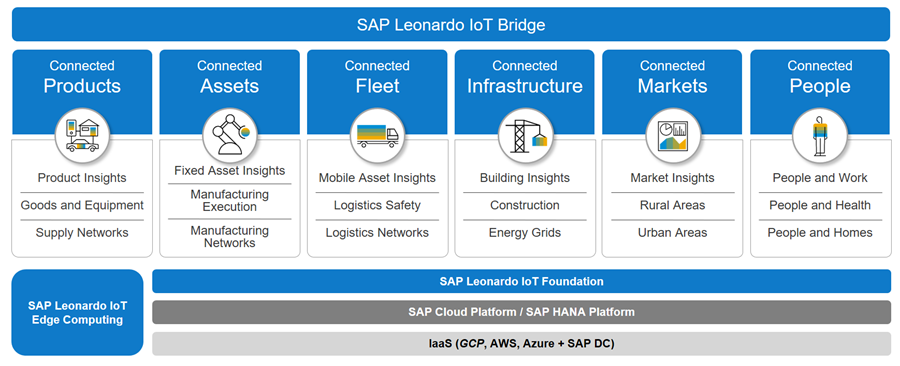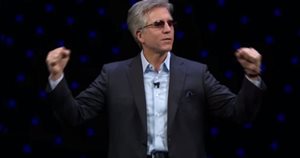SAP is now on AWS, Azure, Google and More SAP News
SAP has announced that its Cloud Platform will run on multiple clouds including Amazon Web  Services, Microsoft Azure, and Google Cloud Platform, meaning that customers can develop and run apps through their choice of infrastructure providers. In conjunction with this announcement, the Walldorf, Germany-based software provider also unveiled an expanded version of Leonardo, its innovation system, to include integrations in machine learning, Internet of Things (IoT), big data, and blockchain technologies, all on its SAP Cloud Platform. Additionally, SAP also announced that it is adding 100 new APIs for S/4HANA, SAP Hybris solutions, and SAP Ariba solutions.
Services, Microsoft Azure, and Google Cloud Platform, meaning that customers can develop and run apps through their choice of infrastructure providers. In conjunction with this announcement, the Walldorf, Germany-based software provider also unveiled an expanded version of Leonardo, its innovation system, to include integrations in machine learning, Internet of Things (IoT), big data, and blockchain technologies, all on its SAP Cloud Platform. Additionally, SAP also announced that it is adding 100 new APIs for S/4HANA, SAP Hybris solutions, and SAP Ariba solutions.
SAP now Offering Multicloud Option
Last February, the vendor changed SAP HANA Cloud Platform into SAP Cloud Platform and it wasn’t just about rebranding, Rather, it was the first step of expanding the role of the SAP Cloud Platform. This change indicated that this will be the cloud platform of choice for every company determined to streamline and reinvent their core business processes with S/4HANA and embrace the new capabilities that arise with IoT, Big Data, and machine learning.
As expected, this week SAP announced that the SAP Cloud Platform can now run across three different clouds, during the company’s annual Sapphire Now conference. The SAP Cloud Platform is already live on Amazon Web Services (AWS), also available as a public preview hosted on Microsoft Azure, and as part of a “demo showcase” on the Google Cloud Platform (GCP). The Cloud Foundry-based SAP Cloud Platform includes multi-language runtime environments, such as Java, Node.js, and the advanced model of SAP HANA extended application services.
With the deepened partnership with Microsoft, besides the fact that SAP’s platform-as-a-service offering is now available as a public preview hosted on Microsoft Azure, Microsoft and SAP are also working to make Azure available as a deployment option for SAP HANA Enterprise Cloud, SAP’s secure managed cloud offering. Additionally, SAP Cloud Platform Identity Authentication Services are now integrated with Azure Active Directory. On top of these, Microsoft’s big M-series virtual machines will be available in the coming weeks first in the U.S., then rolling out to Europe and other regions. With all these enhancements, Microsoft aims at leveraging more intelligence from SAP solution environments with AI, Power BI analytics, Cortana Intelligence, and Office 365.
When it comes to the Google-SAP partnership, integrations with Google's productivity tools, machine learning, Internet of Things, will go on, SAP Netweaver is certified on GCP, and the two companies are connecting Google BigQuery with SAP Analytics Cloud (formerly known as SAP BusinessObjects Cloud).
“SAP’s Biggest Move since SAP HANA”
Another exciting bit of news announced during the event was the expansion of SAP Leonardo. The product was initially designed as SAP’s Internet of Things (IoT) portfolio but with the latest enhancements, the vendor is turning it into a ‘digital innovation platform’ by injecting more machine learning, artificial intelligence, big data analytics and blockchain technologies into the product.

"This is the biggest move our company has made since SAP HANA," CEO Bill McDermott said Tuesday morning in his Sapphire keynote speech. Here are the applications and services that the expansion of SAP Leonardo has to offer:
-
Through SAP Leonardo Centers, initially based in New York, Paris, São Leopoldo, and Bangalore, the enterprise software giant will support developers and partners who want to develop their own custom apps.
-
SAP Leonardo portfolio includes SAP Leonardo Machine Learning Foundation, which is made up of an array of new machine learning-powered applications for enterprises utilizing the SAP Cloud Platform.
-
The Cloud Platform Blockchain service for building application extensions is also included.
-
SAP Service Ticketing, as a part of Hybris Cloud for Customer, categorizes incoming customer service tickets to be forwarded to the right agent.
-
Customer Retention will detect the reason behind unsubscribing as well as the opportunities for upselling to a customer through mining the company data.
-
Job Matching brings together job seekers with "the perfect position", depending on their experience and career goals.
-
Resume Matching ranks candidates to demonstrate their fit with open positions.
-
The SAP CoPilot chatbot is designed to generate human-like conversations and additionally, can be connected with other similar applications such as Slack or Google G Suite.
With the new string of its machine learning applications, the company aims at blowing its rivals out of the water as, during his keynote, McDermott said: "It's not the one who wants the spotlight, it's the one that does the unheralded work that will win." The next step for SAP Leonardo is to cover the supply chain, banking, travel industry, retail, invoice analysis, and accounts payable sectors.
out of the water as, during his keynote, McDermott said: "It's not the one who wants the spotlight, it's the one that does the unheralded work that will win." The next step for SAP Leonardo is to cover the supply chain, banking, travel industry, retail, invoice analysis, and accounts payable sectors.
On top of these announcements, SAP Ariba has also announced a partnership with IBM to deliver cognitive procurement solutions using artificial intelligence (AI) and machine learning. The integrations are expected to bring intelligence from procurement data tied with predictive insights from unstructured data to help customers with enterprise-wide procurement.
SAP Analytics
On the second day of the conference, SAP announced a sheer amount of news on SAP Analytics, as the company puts in, “the most amount of SAP Analytics news at one time since the acquisition of Business Objects.” Here is a great conversation between Byron Banks, VP, Product Marketing at SAP, and Timo Elliott, Global Innovation Evangelist at SAP, highlighting the key takeaways from the event on the SAP Analytics announcements.
My POV
Admittedly, SAP’s cloud strategy has been lagging behind its rivals. However, with the latest announcements, the enterprise software giant is set to catch up in the cloud battle. Especially, the APAC (Asia-Pacific) market is on the German software maker’s radar as its cloud subscriptions and support revenue in the region grew by 65% during the first quarter of 2017.
Having its PaaS on top of public cloud infrastructure will help SAP retain new customers as well as enable existing customers to create innovative extensions. When it comes to running its cloud platform on multiple clouds, this approach is not new for SAP as the company provided its platform on multiple databases in the past. However, the value for SAP is that the software maker will leverage the future build-out of new data centers, depending on customer demand. For its customers, the main value is becoming more agile and nimble as it frees up their resources for delivering business value instead of occupying them to wrestle with all the lower-level technical complexity that is typically associated with enterprise cloud software, such as high-availability, disaster recovery and security, to name few.
Lastly, the value for the cloud providers, Microsoft, Amazon, and Google, is the opportunity for a premium price in return for delivering formidable infrastructure.

Venus Tamturk
Venus is the Media Reporter for CMS-Connected, with one of her tasks to write thorough articles by creating the most up-to-date and engaging content using B2B digital marketing. She enjoys increasing brand equity and conversion through the strategic use of social media channels and integrated media marketing plans.